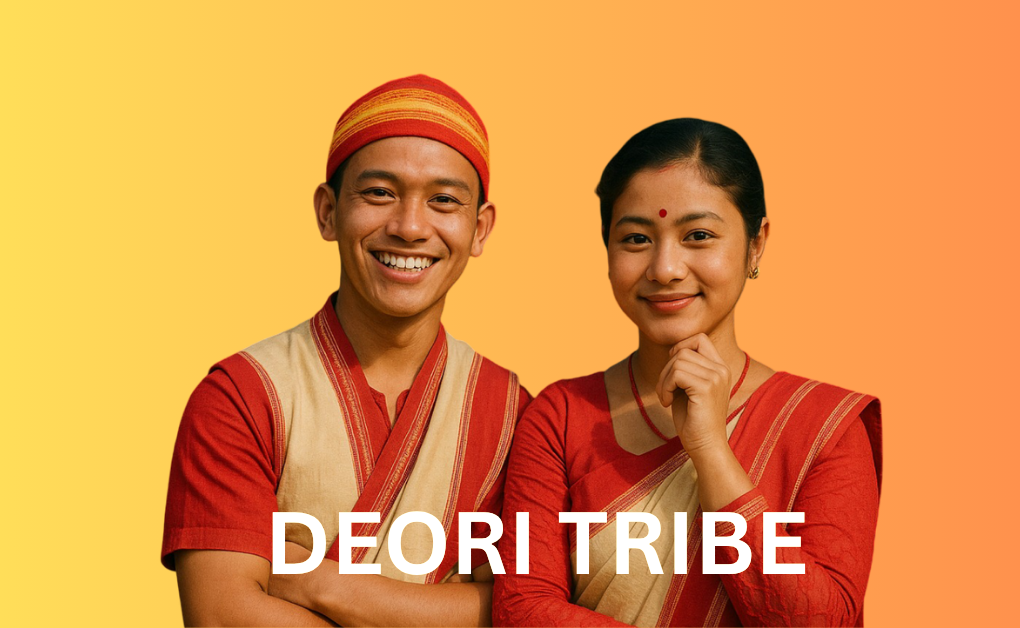The Deori tribe of Assam, one of the four divisions of the ancient Chutiya lineage, holds a unique place in Northeast India’s ethnographic tapestry. While the Hindu Chutiyas, Ahom Chutiyas, and Borahi Chutiyas have assimilated significantly into broader Assamese society, the Deoris have remarkably preserved their age-old traditions, religious practices, and cultural identity amidst centuries of socio-political upheaval.
Historical Origins and Migration of the Deori Tribe of Assam
The Chutiyas, believed to be part of the Bodo race, migrated into Assam through the northeastern mountain passes, establishing powerful principalities along the Brahmaputra. When the Ahoms arrived in 1224 A.D., the Chutiyas were already settled at Sadiya, ruling up to the Desang river. The Deoris trace their early settlement to the banks of rivers Dibang, Tengapani, and Patarsal, now located in Arunachal Pradesh and upper Assam.
Due to inter-tribal conflicts, the Deoris migrated westward and today are mostly found in Lakhimpur, Dibrugarh, Sibsagar, Jorhat, and Sonitpur districts. Their estimated population in 1987 was around 37,000.
Community and Settlement
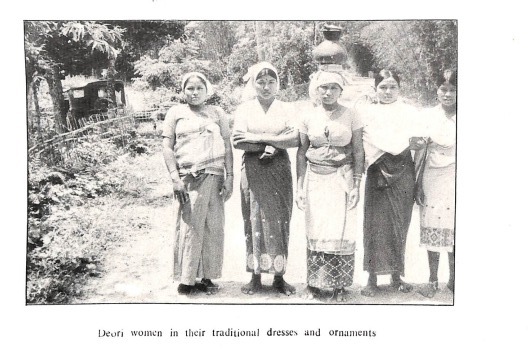
A riverine tribe by nature, the Deoris traditionally build pile dwellings along riverbanks. Their large, bamboo-floored homes, capable of housing over 40 people, reflect a strong sense of extended family and community. The Misso, the front area of the house, serves as a social space, especially for youth and guests. The sacred rear room is reserved for family rituals and is off-limits to outsiders.
Physical Features and Lifestyle
With visible Mongoloid features, the Deoris are known for their strength, simplicity, and hospitality. They maintain cordial relations with non-tribal communities and are industrious agriculturalists, enduring the challenges of flood-prone environments.
Men and women share responsibilities—women help in farming, weaving, and cooking, while also playing an essential economic role by rearing pigs and poultry, which are often sold for supplementary income.
Language and Culture of the Deori Tribe of Assam
The Dibangia subgroup continues to use the traditional Deori language, though other sections like Borgonya and Tengapania have largely shifted to Assamese. Nevertheless, the tribe holds firm to many of its cultural norms, including clan identity and exogamous marriage customs.
Agricultural Economy
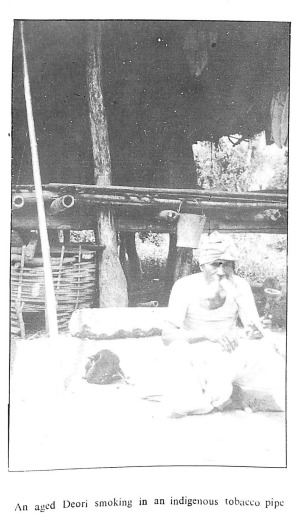
Agriculture is the backbone of Deori livelihood. Ahu paddy (autumn rice) is the staple crop due to the flood-prone terrain, though Sali paddy (winter rice) is now grown thanks to embankments. They also cultivate mustard, sweet potatoes, pulses, cotton, and more recently wheat and lentils. While a few families have embraced modern farming tools, most still use traditional ploughs and organic manure.
Food and Beverages
Rice is central to the Deori diet, often accompanied by boiled greens and home-reared meats like duck, fowl, pig, and goat. Fish is a delicacy, and community fishing is common during winter. One of the tribe’s cultural hallmarks is rice beer (Suze), brewed in every household and offered generously to guests. Tea is not widely consumed; elders prefer unsweetened red tea.
Family and Social Organization
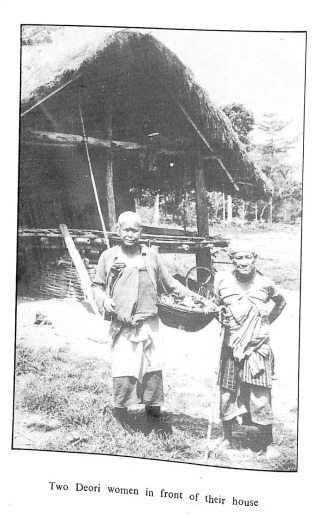
The Deoris largely follow a joint family system. Their social units are referred to as Jupa, with the Jakaruă Jupa encompassing multiple generations under one roof. Property is patrilineal—sons inherit land and assets, while women maintain domestic influence but do not inherit property.
There are four major divisions or Khels—Dibangia, Tengapania, Borgonya, and Patargonya—each with exogamous clans known as Bangshas (Jakus). While clans play a key role in marriage customs, they do not influence social hierarchy.
Religion and Rituals
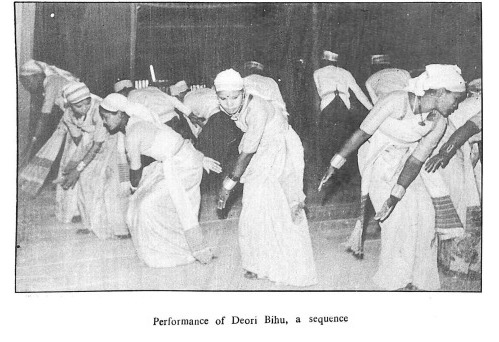
Despite outside influences, the Deoris retain a vibrant religious structure. Their primary worship spaces are called Thān (or Midiku among the Dibangias), dedicated to deities such as Kundi Mämä (Shiva-Parvati), Pisa Dema, and Pisāsi Dema. They also worship household deities, believing these protect the well-being of the family.
Each village has nine ritual functionaries, including the highly revered Bor Deori, Saru Deori, and Deodhai, the latter believed to channel divine voices during trances. Animal sacrifices and sacred Wednesdays feature prominently in their ritual calendar.
Marriage and Bride Price
Marriage is a vital institution for the Deoris, and monogamy is the norm, although polygyny is not unknown. Clan exogamy is strictly enforced, with marriage within the same moiety forbidden. Traditional marriage types include Bor Biya (grand marriage), Maju Biya (moderate), Bhakat Rupiya (simple), and Gandharba (elopement).
A bride price is customary, typically ₹126 but can go up to ₹300 in elopements. Importantly, the bride’s family also gives a dowry, which may exceed the value of the bride price and includes utensils, clothes, and other household items.
Festivals and Performing Arts
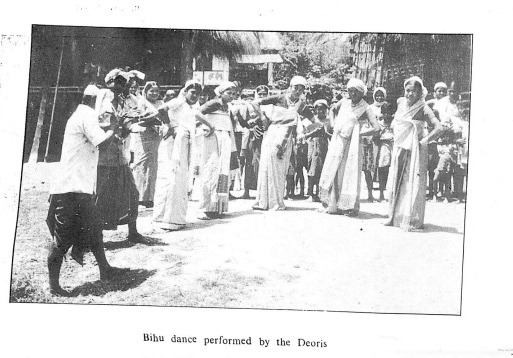
The Deoris celebrate two major festivals:
- Bohag Bihu (Bohagiyo Bisu) – Celebrated in April before sowing
- Magh Bihu (Magiyo Bisu) – Celebrated in January before harvesting
Both begin with ritual sacrifices and Than pujas. A unique aspect of Deori Bihu is the Deodhani dance, a trance performance by a chosen medium believed to embody divine spirits. Community feasts, Husari singing-dancing troupes, and ceremonial blessings characterize these festivals.
Death and Funeral Practices
Cremation is the norm except in cases like children, pregnant women, or epidemic deaths, where burial is practiced. The funeral includes egg rituals, rice beer offerings, and purification with holy water. The final death ceremony, an expensive affair, is typically held after a year and includes communal feasting.
Modern Influence and Adaptation
Today, many Deori families live in Assam-type houses. Items like radios, steel utensils, modern clothing, and ornaments are increasingly common. Though allopathic medicine is slowly replacing traditional healing, and education and modern employment are gaining traction, the Deoris continue to preserve their core cultural and religious identity.
Conclusion: Preserving the Cultural Identity of the Deori Tribe of Assam
The Deori tribe of Assam stands as a living example of how a community can embrace change while preserving its cultural heritage. Their resilience, social unity, and deep-rooted spiritual beliefs make them one of Assam’s most culturally rich and intriguing indigenous communities. As modernization spreads, the Deoris continue to balance their ancient customs with a forward-looking mindset, ensuring that their legacy endures through generations.



